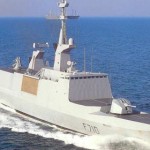I was at Mumbai’s naval dockyard to tour the French Navy’s frigate, La Fayette, courtesy the French Embassy in India. The warship, on its deployment in the Indian Ocean, was in the city for a week on a goodwill visit.
As I stepped on board, I could see through the driving rain that the city received last week, the silhouette of INS Mormugao, the Indian Navy’s most advanced stealth guided missile destroyer, launched just a few weeks prior. The French naval attaché and the ship’s captain thought just as I did, that India ought to be proud of its naval prowess.
Built by the DCNS, the same shipyard involved in India’s Scorpène submarine project, La Fayette is a 3000+ tonnes displacing general purpose frigate. It is one of the first-of-a-kind stealth frigates in the world that the French Navy inducted way back in 1996 and the leading ship of its class. Stealth frigates are designed to reduce radar signature and make minimum noise while sailing. Ever since, most major navies, including India, have extensively incorporated stealth features in the designing and building of ships.
Taking us on a guided tour of the ship, the Captain explained how the crew operated. Firstly, it’s a lean crew since technology is used for automation. Also, French military planners have, for the longest time, attempted to instill synergy in their defence forces for greater coordination between the three wings. This is done in two ways: developing weapons platforms which, with modifications, can be operated across – air, ground and water — and regularly cross-deploying personnel on important military missions. So presently, La Fayette’s deputy captain is a trained fighter pilot, who can seamlessly work with the French Air Force if the need arises. Also, one of the counter-piracy deployments of the French Navy is currently headed by a French Army general.
In terms of equipment, the French Navy already operates the Rafale fighter jet, which can take off both from land and an aircraft carrier. This is an important aspect of the functioning of the French military, particularly because India’s own efforts at aligning military planning and operations have yielded limited success due to rivalry between the three wings of its armed forces.
Over a cup of coffee the captain asked me about the Indian Navy’s threat perception, its priorities and modernisation plans and spoke approvingly of how the annual ‘Varuna’ naval exercises between India and France had helped both navies evolve a working relationship.
As I disembarked, Mormugao loomed up once again in the middle distance. Both stealth ships symbolised, in a sense, the Indian and French intent to stand shoulder to shoulder in taking maritime challenges head-on.
Sameer Patil is Fellow, National Security, Ethnic Conflict, and Terrorism Studies, Gateway House.
This blog was exclusively written for Gateway House: Indian Council on Global Relations. You can read more exclusive blogs here.
For interview requests with the author, or for permission to republish, please contact outreach@gatewayhouse.in, or call 022 22023371.
©Copyright 2016 Gateway House: Indian Council on Global Relations. All rights reserved. Any unauthorized copying or reproduction is strictly prohibited.


